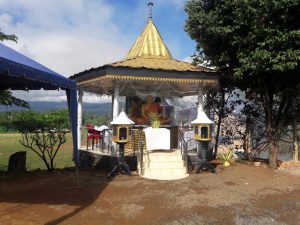
 History of the local government system of our country which goes back to 337 BC with a written history but the unwritten legend of the Ravana reign that still exists in the Uvaparanagama area reveals that it was active long before that. In the Mahavanshaya, one of the oldest historical books in Sri Lanka, it is mentioned that the existence of the local government system was formalized during the reign of King Pandukabhaya. “Anuradha Grama” which was formed after the King Vijaya arrived was developed as a city “Anuradhapura” and the conservator for that city was appointed as “Nagara Guttika”. There are evidence in the history book that “Nagara Guttika” was appointed to administer the city administration and to administer the garbage Cleaning and activities such as maintenance of cemeteries and gardens.
History of the local government system of our country which goes back to 337 BC with a written history but the unwritten legend of the Ravana reign that still exists in the Uvaparanagama area reveals that it was active long before that. In the Mahavanshaya, one of the oldest historical books in Sri Lanka, it is mentioned that the existence of the local government system was formalized during the reign of King Pandukabhaya. “Anuradha Grama” which was formed after the King Vijaya arrived was developed as a city “Anuradhapura” and the conservator for that city was appointed as “Nagara Guttika”. There are evidence in the history book that “Nagara Guttika” was appointed to administer the city administration and to administer the garbage Cleaning and activities such as maintenance of cemeteries and gardens.
With the migration of the Aryans to the country after the 4th century BC, new sections were added to the local government. History bears witness to the existence of a system called “Sansthawa” with the system of government, which later began to function in a form required by the country called “Gam Sabha”.
During the long monarchy, various forms of local government, known as the Gam Sabha, played a major role in the survival of the monarchies.
Ceylon was colonized by the British. The “Gam Sabha” system was active in the country in 1815, and in 1818 the English government abolished the “Gam Sabha” system completely in Ceylon, as it appeared to have made an active contribution to local government and the country’s warfare, military organization, etc.
Subsequently Soulbury, Communist, incorporated councils into the local government system in Ceylon under which the establishment of “Gam Sabha” in 1866 marked the establishment of the Colombo and Kandy Municipal Councils. At the time of independence, there were four types of Local Government Institutions established under British law in Sri Lanka, namely, viz.
- Municipal Councils
- Urban Councils
- Town Councils (Sulu Nagara Sabha)
- Village Committees (Gam Sabha)
The Village Committees (Gam Sabha) and Town Councils (Sulu Nagara Sabha) were abolished by the Development Councils Act in 1981, and Development Councils were established and Due to its failure, the Pradeshiya Sabha was established by Act No. 15 of 1987, renaming the sub-offices of this Development Council as the Pradeshiya Sabha.
To improve the efficiency of the Local Government Institutions, the then government abolished all the Village Committees (Gam Sabha) and Town Councils (Sulu Nagara Sabha) in Sri Lanka and established the District Development Council System on 1st of July, 1981. Accordingly, 06 Gam Sabhas within the Uvaparanagama Pradeshiya Sabha area and 06 Gam Sabhas among the District Development Councils became Sub District Offices of the District Development Council. Accordingly, the administration activities have been carried out by naming Ambagasdowa, Ranhawadigama, Pannalawela, Kotawara, Bambarapana sub-office and Maspanna sub-office.
All proposals for regional development activities were approved by the District Development Council. The weakest part of this system is that only one representative was elected to represent the electorate. He is known as a Member of the District Development Council. Due to the severe injustice that was occurred to the undeveloped villages in allocating funds for development activities under this system, the District Development Council system was also abolished by the then government, enacting the Pradeshiya Sabha Act No. 15 of 1987 with effect from 1st of January, 1988.
Due to unrest in the country and the difficulty in holding elections, special commissioners were appointed to govern these Pradeshiya Sabhas in 1988. Subsequently, local government elections were held in 1990, and 19 representatives were elected to the Uvaparanagama Pradeshiya Sabha. Its first chairman was Mr. D.M. Sirisena, a member of the United National Party from Dimbulana. Following his resignation from the post to contest as a candidate for the Uva Provincial Council shortly afterwards, then Hon. Deputy Chairman Mr. Pujitha Dharmasena served as the Hon. Chairman for a short period. Thereafter, Mr. D.M. Kiribanda, a resident of Kotawara was appointed as the Hon. Chairman.
After his term of office, Mrs. Punya Wijekoon was elected as the Hon. Chairman from 25th of April, 1997. Mrs. Kanchana Ruwanmali Malwatta was appointed as the Hon. Chairman on 21st of March, 2002 after the end of her term of office. Following the end of that term of office, Hon. Punya Wijekoon was re-elected as the Chairman from the year 2006. Following her term of office, Hon. Punya Wijekoon was re-elected as the Hon. Chairman in the Local Government Elections held in 2011. After the dissolution of the Pradeshiya Sabha on 30th of May, 2015, her term of office also came to an end. Afterwards, the governance has come under the control of the special commissioner. After the local government election held on the 10th of February, 2018, Mr. K.A. Saminda Sudarshana was appointed as the Chairman on the 29th of March, 2018. He has been holding that post till now.
